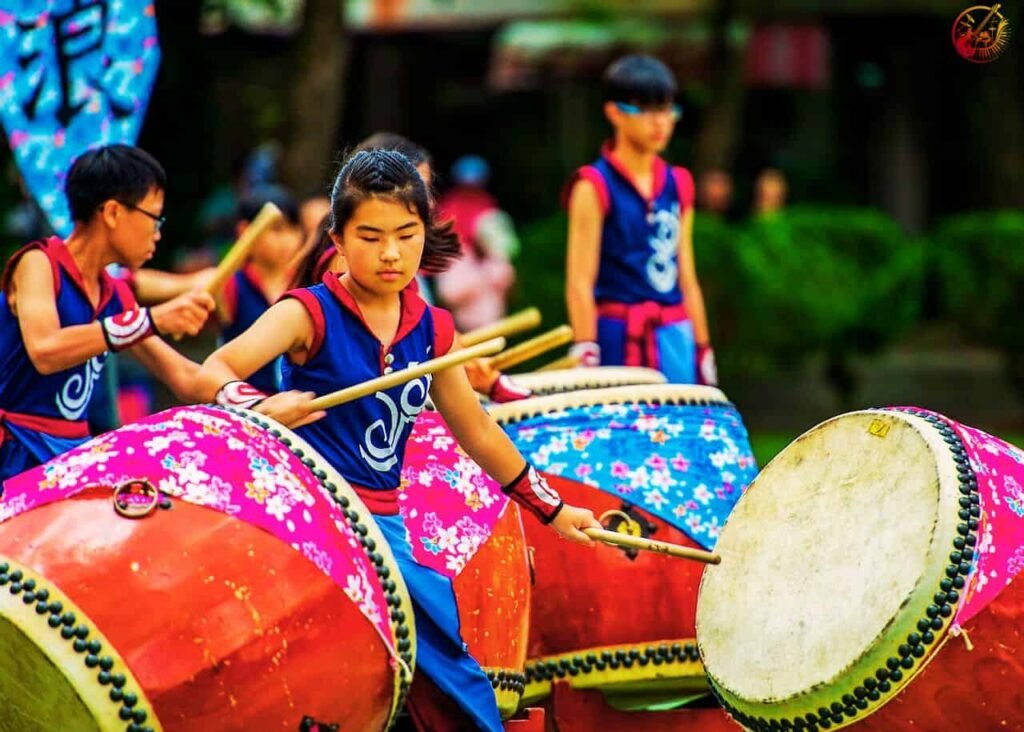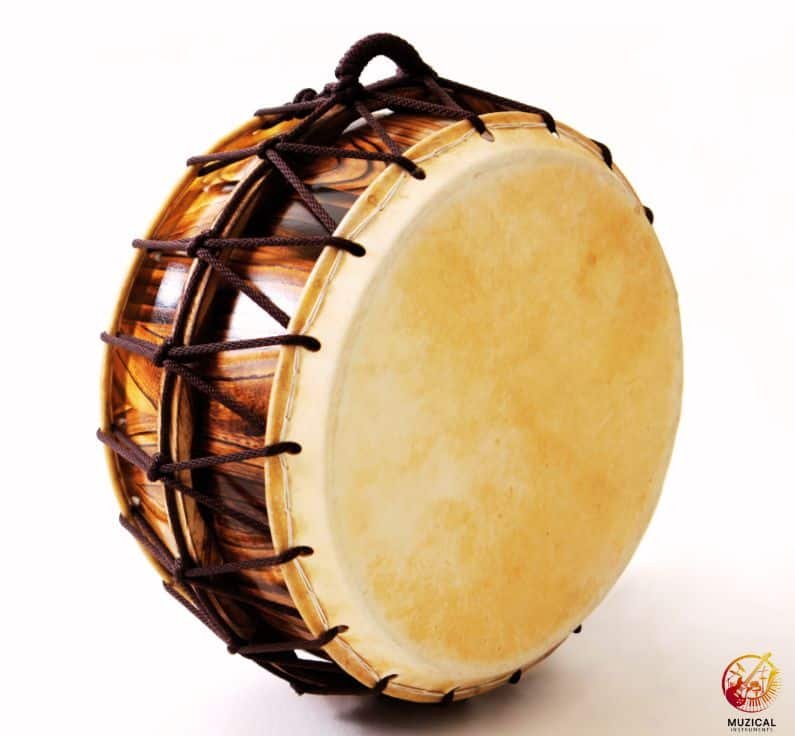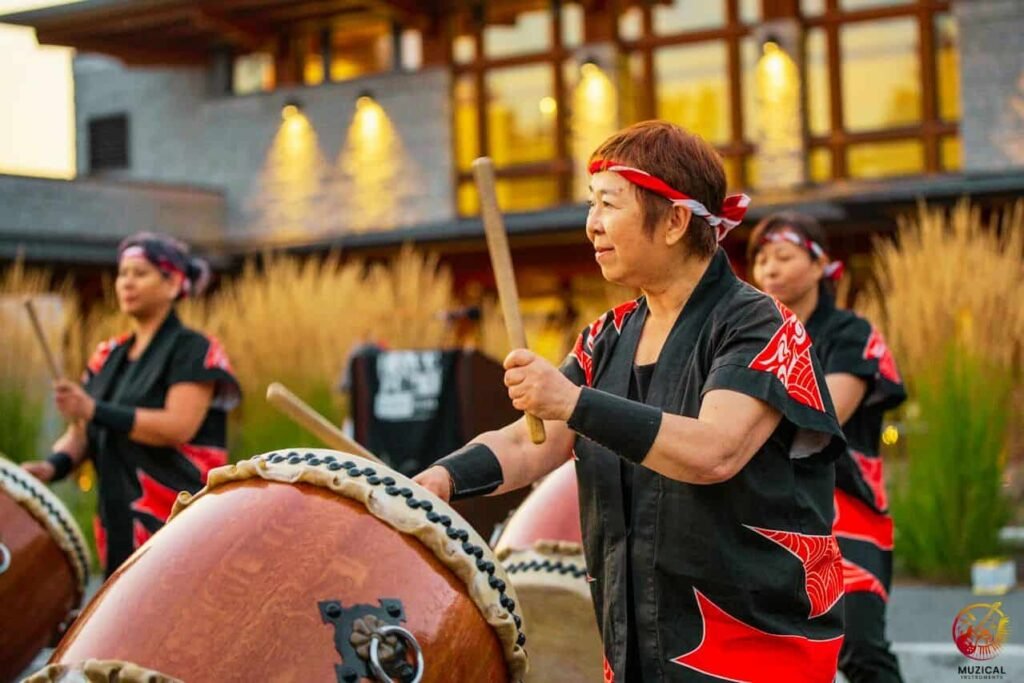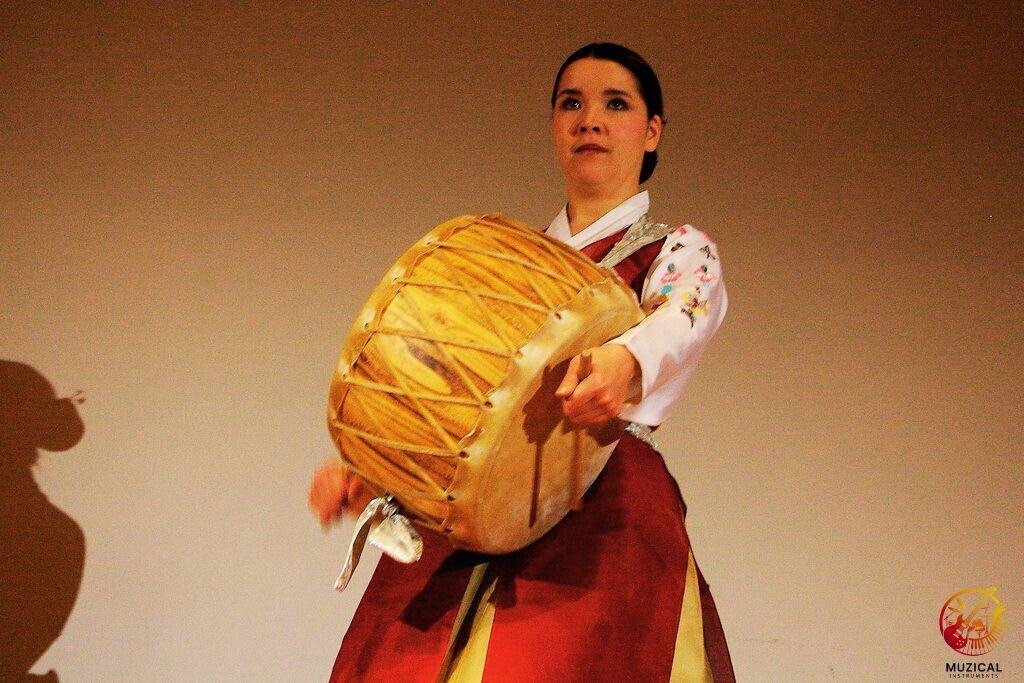What’s the Difference Between Taiko and Buk Drums?
The difference between Taiko and Buk drums goes far beyond just shape or size. These two drums come from Japan and Korea and each carries its own soul, story, and sound. At first glance, they might look alike; big, bold, and built to be heard. But once you listen closely, you’ll hear how differently they speak.
The Taiko is loud and strong, made for deep power and wide-open spaces.
The Buk is lighter and quicker, made for rhythm, dance, and playful flow.
One demands silence between strikes. The other invites voices to join in.
This isn’t just about music. It’s about how two cultures used drums to express who they are, what they believe, how they move, and how they connect.
In this article, you’ll learn:
- How Taiko and Buk drums differ in shape, sound, and construction
- Where and how each is used in festivals, rituals, and daily life
- Why their differences reflect Japanese and Korean values
- Practical insights for drummers, instrument makers, and music lovers
Let’s unpack the key contrasts that separate these two legendary East Asian percussion instruments.
The Difference Between Taiko and Buk Drums in Design and Construction?
When you touch a drum, what you feel is more than wood and leather. You’re holding centuries of design shaped by geography, climate, and belief. That’s why Taiko and Buk don’t just sound different. The core difference between Taiko and Buk drums is that they’re built from the ground up with different goals.

Shape and Frame
The most noticeable difference is in the body shape.
- The traditional Japanese drum known as the Taiko, especially the Nagadō–daiko, has a barrel–shaped drum body carved from a single log. It’s thick and heavy, often made of zelkova or cypress wood.
- The Buk is a traditional Korean drum with a cylindrical or hourglass shape. It’s made from wood panels joined together, a lighter design with a flat drum surface. Paulownia and pine are common materials for these wooden body percussion instruments.

Drumhead and Tension
- Taiko drums have cowhide heads nailed directly to the frame. The tension is fixed, giving a deep, booming tone that doesn’t change.
- Buk drums are rope–tension drums. You can tighten or loosen the ropes to tune the pitch. Some use deerskin instead of cowhide for different tonal effects. This adjustability is ideal for Korean folk drumming.
Drumsticks and Playing Style
- Taiko drummers use bachi, large, solid drumsticks. The drumstick size and shape add weight and power to every strike.
- Buk players use janguchae, light sticks or bamboo beaters. These are better for fast rhythms and playful drumming.
Design and Construction
| Feature | Taiko Drum | Buk Drum |
|---|---|---|
| Body Shape | Barrel-shaped drum (single log) | Cylindrical/hourglass (panel-built) |
| Drumhead Tension | Fixed (nailed) | Adjustable (rope-laced) |
| Drumhead Material | Cowhide | Cowhide or deerskin |
| Stick Type | Bachi (heavy wood) | Janguchae (light or bamboo) |
| Sound Range | Deep, booming | Sharp, tunable, rhythmic |
| Wood Used | Zelkova, Cypress | Paulownia, Pine |
Expert Insight:
“Japanese drums are built to be heard outdoors in wide-open spaces. Korean drums are tuned for interplay, dialogue, and storytelling.” Kim Dae-hyun, Korean percussionist
How Are Taiko and Buk Used in Cultural Life?
The role of a drum in society often says more than the drum itself. While both Taiko and Buk carry strong national identities, the way they play very different parts in cultural life highlights a key difference between Taiko and Buk drums.
Taiko in Japanese Society
A traditional Japanese drum is more than an instrument. It’s a performance, a ritual, a form of discipline.
- Japanese festival music: During Matsuri (festivals), large festival drums like the Taiko lead the parade. They’re loud, dramatic, and central to the celebration.
- Drumming in temple rituals: Buddhist temples use Taiko to mark time and purify space. The sound is part of a spiritual practice.
- Modern Taiko ensembles: Groups like Kodo blend drumming with dance, martial arts, and story. Taiko is about strength, unity, and focus.
In Japan, Taiko is tied to discipline, unity, and strength. Players train like athletes. Every beat follows a form. It’s not just drumming, it’s a philosophy.
Buk in Korean Culture
The Buk is a traditional Korean drum that beats with everyday life.
- Korean folk drumming: In Pungmul, Buk drums lead outdoor music and dance in village fields. The beat keeps dancers and singers together.
- Samulnori: A stage-based update of folk music, where the Buk joins gongs and other drums to create complex rhythms.
- Court and temple music: During the Joseon Dynasty, Buk drums were part of Buddhist rituals and Confucian ceremonies. Softer strokes were used in these settings.
Korean drumming is often playful, communicative, and improvisational. Drummers interact with dancers, singers, and even the audience. The Buk’s tunability makes it perfect for quick, expressive changes.
Cultural Comparison Table
| Use Case | Taiko (Japan) | Buk (Korea) |
|---|---|---|
| Festival Role | Central, loud, ceremonial | Rhythm base, community dance |
| Spiritual Role | Buddhist and Shinto rituals | Confucian rites, Buddhist events |
| Folk Tradition | Limited | Strong in daily life and protest |
| Performance Style | Ensemble, choreographed | Interactive, improvisational |
| Cultural Drumming Traditions | Disciplined, powerful | Playful, responsive |
Pro Tip:
Want to feel like a warrior? Try Taiko. Want to play with others and tell stories through sound? The Buk may be your match.
What Do These Drums Sound Like?
This is where the two drums diverge the most, especially if you’re a performer or composer.
The Taiko Sound
Taiko is loud, deep, and rich. The body size and non-adjustable heads give it a booming bass you can feel in your chest. This is no background instrument, it demands attention.
- Perfect for outdoor spaces, parades, and dramatic tension.
- One strike can fill a stadium, no mic needed.
- Has a ceremonial weight, even silence between strikes has meaning.

The Buk Sound
The Buk is more versatile, sharper, and quicker.
- Works best in rhythmic layers, with other instruments.
- Easier to tune and control for faster tempo pieces.
- Offers more pitch flexibility, especially in ensemble drumming.
Think of Taiko as a gong and Buk as a talking drum. One declares. The other converses.
| Feature | Taiko Drum Sound | Buk Drum Sound |
|---|---|---|
| Volume Level | Very loud, echoing | Moderate, adaptable |
| Tonal Range | Fixed, deep | Tunable, mid-high range |
| Best Setting | Outdoors, temples, large spaces | Indoor stages, street dances |
| Emotion | Grounding, majestic | Lively, intimate |
Analogical Tip:
If Taiko is thunder, Buk is a heartbeat. Both essential. Both emotional. But very different roles.
What History Shaped These Drums?
Culture doesn’t happen in a vacuum. Geography, politics, and religion all shape how an instrument grows. That’s why understanding the past helps you see why Taiko and Buk evolved the way they did.
Japanese Roots: Taiko’s Long March
- Origin: The earliest Taiko traces date back to the 6th century, possibly from Chinese or Korean influence, but quickly developed a unique Japanese style.
- Feudal Japan: Used in battle to rally troops and scare enemies. Also part of Shinto and Buddhist ceremonies.
- Isolation Period: During Edo era, Taiko was localized to festivals and temple grounds, which preserved its form and mystique.
Taiko grew in scale and stature. As Japan industrialized, it transformed into a performance art that symbolized strength and harmony.

Korean Path: Buk’s Folk Heartbeat
- Origin: The Buk’s history is deeply tied to Korean folk traditions, possibly influenced by Central Asian nomadic drums.
- Joseon Dynasty: Buk drums were used in Confucian court music and temple rituals, but also found in everyday village life.
- Colonial Impact: During the Japanese occupation, Korean instruments like the Buk were suppressed. After independence, the Buk became a symbol of national identity.
Buk drums tell the story of a people who used rhythm to resist, remember, and rebuild.
| Influence Area | Taiko (Japan) | Buk (Korea) |
|---|---|---|
| Historical Era | Feudal Japan, Edo | Joseon, post-occupation |
| Roots | Ceremonial, martial | Folk, nomadic |
| Political Role | National image, exported art | Cultural pride, resistance |
Contrarian View:
Some say Taiko has become too polished, losing its original ritual soul. Buk, tied deeply to people and protest, may evolve more freely.
Final Thoughts: Which Drum Speaks to You?
Taiko and Buk are more than just traditional drums from Japan and Korea. They are voices of their people. One booms with form. The other dances with freedom. One is carved from a single log to speak like a storm. The other is pieced together to join the chorus.
You’ve learned:
- The core design differences between these historical drum styles
- Their cultural drumming traditions and roles in society
- How sound and shape are linked in regional drum design differences
- What each drum says about the people who play them
Now that you understand the difference between Taiko and Buk drums, which will you choose?
The thunder of a large festival drum, or the heartbeat of a flat drum surface built for stories?
Next Step: Watch a Taiko vs Buk performance. Don’t just listen. Feel the story.
Beyond performance, learn how Taiko drumming is used in meditation and healing to calm the mind and connect with rhythm on a deeper level.
FAQs About Taiko vs Buk Drums
Q: Are Taiko drums always large?
Not always. While some, like the Odaiko, are massive, there are smaller types such as the Shime-daiko used for different purposes.
Q: Can Buk drums be used solo or are they only for group music?
Both. Though common in ensemble music like Samulnori, Buk can also be played solo in improvisational or performance settings.
Q: What’s the difference between the sound of a barrel-shaped drum and a flat-surfaced drum?
Barrel-shaped drums like the Taiko produce deep, resonant booms. Flat drums like the Buk offer crisper, tunable sounds with more pitch variety.
Q: Why is rope tension important in Buk drums?
Rope tension lets the player adjust pitch and tone, which is key in Korean music styles that need flexibility and quick rhythm changes.
Q: Are Taiko drums used outside Japan?
Yes. Taiko ensembles exist worldwide. Groups in North America, Europe, and South America have adopted this traditional Japanese drum in modern contexts.
Q: Is it hard to learn Taiko or Buk?
Both need practice, but for different reasons. Taiko focuses on power and form. Buk emphasizes rhythm and communication. Choose based on your interest.
Q: What materials are best for building these drums?
Traditional Taiko uses zelkova or cypress wood and cowhide. Buk uses lighter woods like paulownia or pine and may use deerskin for flexibility.
